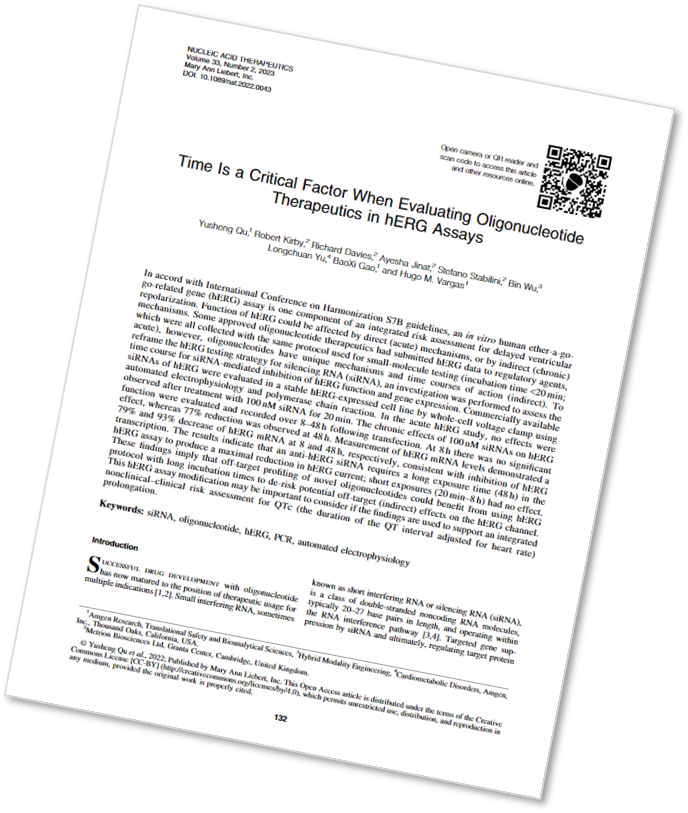By Robert Kirby, COO, Metrion Biosciences
Last year we worked alongside authors from Amgen and published data in support of refining the hERG testing strategy for silencing RNA (siRNA). In accordance with the ICH S7B guidelines, an in vitro assay targeting the hERG channel forms a crucial component of the integrated risk assessment for delayed ventricular repolarization. The function of hERG may be influenced by either direct (acute) mechanisms or indirect (chronic) mechanisms. While some approved oligonucleotide therapeutics have submitted hERG data to regulatory bodies, gathered using protocols akin to small-molecule testing (with an incubation time <20 min, indicative of acute effects), oligonucleotides operate via distinct mechanisms and timelines (notably indirect effects).
The study examined commercially available siRNAs targeting hERG in a stable hERG-expressing cell line using automated patch clamp electrophysiology, and PCR analyses. Acute testing revealed no discernible effects following a 20-minute, 100 nM siRNA treatment. However, chronic effects over 8 to 48 hours post-transfection unveiled a substantial 77% reduction in hERG expression after 48 hours, contrasting with no significant impact at 8 hours. Analysis of hERG mRNA levels demonstrated a consistent decrease of 79% and 93% at 8 and 48 hours, respectively, indicative of inhibited hERG transcription.
This underscores the potential value of employing hERG protocols with extended incubation times in off-target profiling of novel oligonucleotides to mitigate the risk of indirect effects on the hERG channel. Such modifications to the hERG assay protocol merit consideration, particularly when supporting an integrated nonclinical-clinical risk assessment for QTc prolongation.
Read the full publication: Yusheng Qu, Robert Kirby, Richard Davies, Ayesha Jinat, Stefano Stabilini, Bin Wu, Longchuan Yu, BaoXi Gao, and Hugo M. Vargas, Nucleic Acid Therapeutics 2023 33:2, 132-140.
Find out about our GLP hERG screening services.

By Robert Kirby, COO, Metrion Biosciences
Last year we worked alongside authors from Amgen and published data in support of refining the hERG testing strategy for silencing RNA (siRNA). In accordance with the ICH S7B guidelines, an in vitro assay targeting the hERG channel forms a crucial component of the integrated risk assessment for delayed ventricular repolarization. The function of hERG may be influenced by either direct (acute) mechanisms or indirect (chronic) mechanisms. While some approved oligonucleotide therapeutics have submitted hERG data to regulatory bodies, gathered using protocols akin to small-molecule testing (with an incubation time <20 min, indicative of acute effects), oligonucleotides operate via distinct mechanisms and timelines (notably indirect effects).
The study examined commercially available siRNAs targeting hERG in a stable hERG-expressing cell line using automated patch clamp electrophysiology, and PCR analyses. Acute testing revealed no discernible effects following a 20-minute, 100 nM siRNA treatment. However, chronic effects over 8 to 48 hours post-transfection unveiled a substantial 77% reduction in hERG expression after 48 hours, contrasting with no significant impact at 8 hours. Analysis of hERG mRNA levels demonstrated a consistent decrease of 79% and 93% at 8 and 48 hours, respectively, indicative of inhibited hERG transcription.
This underscores the potential value of employing hERG protocols with extended incubation times in off-target profiling of novel oligonucleotides to mitigate the risk of indirect effects on the hERG channel. Such modifications to the hERG assay protocol merit consideration, particularly when supporting an integrated nonclinical-clinical risk assessment for QTc prolongation.
Read the full publication: Yusheng Qu, Robert Kirby, Richard Davies, Ayesha Jinat, Stefano Stabilini, Bin Wu, Longchuan Yu, BaoXi Gao, and Hugo M. Vargas, Nucleic Acid Therapeutics 2023 33:2, 132-140.
Find out about our GLP hERG screening services.

By Robert Kirby, COO, Metrion Biosciences
Last year we worked alongside authors from Amgen and published data in support of refining the hERG testing strategy for silencing RNA (siRNA). In accordance with the ICH S7B guidelines, an in vitro assay targeting the hERG channel forms a crucial component of the integrated risk assessment for delayed ventricular repolarization. The function of hERG may be influenced by either direct (acute) mechanisms or indirect (chronic) mechanisms. While some approved oligonucleotide therapeutics have submitted hERG data to regulatory bodies, gathered using protocols akin to small-molecule testing (with an incubation time <20 min, indicative of acute effects), oligonucleotides operate via distinct mechanisms and timelines (notably indirect effects).
The study examined commercially available siRNAs targeting hERG in a stable hERG-expressing cell line using automated patch clamp electrophysiology, and PCR analyses. Acute testing revealed no discernible effects following a 20-minute, 100 nM siRNA treatment. However, chronic effects over 8 to 48 hours post-transfection unveiled a substantial 77% reduction in hERG expression after 48 hours, contrasting with no significant impact at 8 hours. Analysis of hERG mRNA levels demonstrated a consistent decrease of 79% and 93% at 8 and 48 hours, respectively, indicative of inhibited hERG transcription.
This underscores the potential value of employing hERG protocols with extended incubation times in off-target profiling of novel oligonucleotides to mitigate the risk of indirect effects on the hERG channel. Such modifications to the hERG assay protocol merit consideration, particularly when supporting an integrated nonclinical-clinical risk assessment for QTc prolongation.
Read the full publication: Yusheng Qu, Robert Kirby, Richard Davies, Ayesha Jinat, Stefano Stabilini, Bin Wu, Longchuan Yu, BaoXi Gao, and Hugo M. Vargas, Nucleic Acid Therapeutics 2023 33:2, 132-140.
Find out about our GLP hERG screening services.
